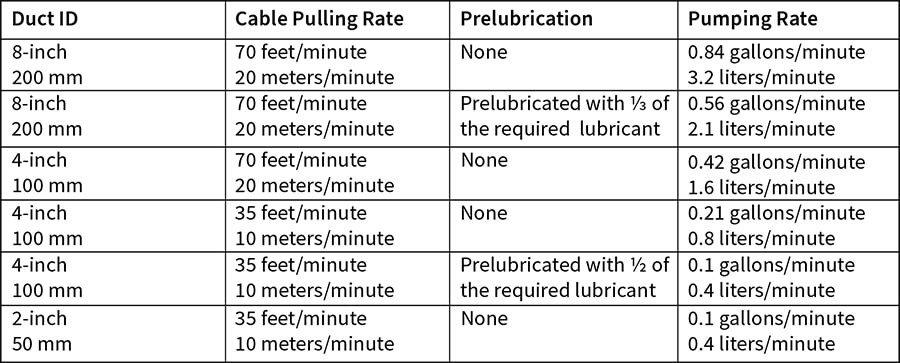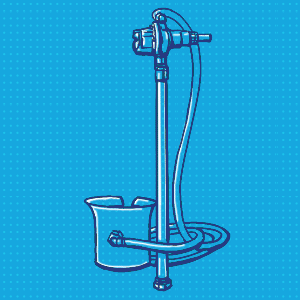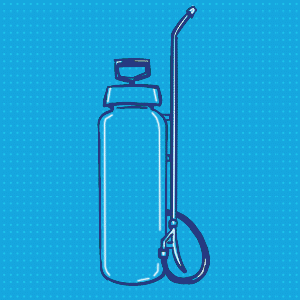Guide to Cable Lubricant Pumping
Automatic lubrication frees up the labor normally required for hand lubrication and provides more consistent and optimal lubricant use. In addition, it is safer and less messy. Polywater® has experience applying lubricants using various kinds of pumps from the 1970’s through today. This experience is valuable for anyone interested in automatic lubrication. There are several design considerations for a cable pulling lubricant pumping system. Below we review the key factors driving pump choice and then describe a few pump options.
How do I know if the pump is compatible with water-based cable lubricants?
The pump system must be compatible with high-performance cable lubricants. The pump should not damage the lubricant, and the lubricant should not damage the pump:
- The pump should not shear, froth, or otherwise degrade the cable lubricant.
- The water-based lubricant should not corrode the pump.
Cable lubricants are complex polymer systems, and the pumping mechanism should not shear this mixture. High shear pumps may also cause the lubricant to froth or foam. It is important the pump does not degrade or change the lubricant properties. Pumps should be designed to work with water-based materials. While piston-style grease pumps work for a while, unless they are coated steel, stainless, aluminum, or non-metallic, they eventually corrode from the water-base materials. Suitable pumps are found in the chemical, food processing, agricultural, sewage, marine and medical industries.
| Unsure if you have the right lubricant for the job? Click here to explore Polywater’s lubricants. |
What kind of power source is needed and available for my pumping system?
Since most cable installation sites are remote, it is important to consider how the pump will be powered. There are pumping options that utilize air power (compressor driven), battery power (12 or 18 volt or rechargeable), and electric power. The choice of power source is a balance between what is needed and what is available. Pumping at a higher rate for further distances requires more power.
How much pumping capacity do I need?
The pumping capacity consideration can be broken into two parts:
- Pumping Rate: The amount of lubricant needed per time increment.
- Pumping Power: The distance the lubricant must travel through the hose and the effort it will take to move it there.
The pumping rate is a critical component to determine capacity requirements. It depends on both how much lubricant is needed as well as the speed of the cable pull.
| Related Content: The Lubricant Difference: Matching Product to Project |
Calculating Pumping Rate
For most pulls, the pumping rate is less than 1 gallon (~4 liters) per minute. The calculation requires the installer to know how much lubricant is needed as well as how fast the cable is traveling. The lubricant quantity is directly related to the surface area to be coated with lubricant and can be found using the lubricant quantity formula:
Equation 1
Q = K x L x D
Where:
Q = quantity in gallons (liters)
K = conversion factor, 0.0015 (0.0008 metric)
L = length of duct run in feet (meters)
D = ID (inner diameter) of the duct in inches (mm)
| Polywater can help determine the amount of lubricant needed for any job. Click here to try our lubricant calculator. |
The bigger the duct system, the more lubricant is needed. If you go from 4 inches (100 mm) to 8 inches (200 mm), the quantity requirement will double. For more difficult installations, prelubrication is recommended. Any lubricant added and spread through the duct ahead of the cable pull is part of the lubricant quantity recommendation. Pumps can be used to inject lubricant into the pump ahead of lubricant spreaders. In this case, the pumping rate is less important.
If the conduit is prelubricated, the amount of lubricant used can be subtracted from the quantity calculated using the quantity formula. The remaining lubricant is coated onto the moving cable as it enters the conduit. This means that cable speed is an important part of the pumping rate calculation. A cable moving 70 feet/minute (20 meters/minute) requires twice as much lubricant per minute as that of a cable moving 35 feet/minute (10 meters/minute). See Equation 2.
Equation 2
![]()
Where:
Pumping Rate is in gallons per minute (liters per minute)
Q = lubricant quantity in gallons (liters) from Equation 1
QP = quantity of lubricant used to prelubricate duct
L = length of duct run in feet (meters)
R = rate of installation in feet per minute (meters/min.)
The key factors determining pumping rate are duct size and cable installation speed. Note that the length of the run does not impact pumping rate. The length of the run is used to calculate the total quantity of lubricant needed. The length is then divided out of the formula to determine pumping rate. Graph 1 illustrates some examples of pumping rate.
Graph 1: Pumping Rate Based on Duct Size and Pull Rate

Note that the pumping rate for the 4-inch (100 mm) duct is half of that required for the 8-inch (200 mm) duct. It is a linear relationship. Note that the lubricant quantity needed when pulling at 35 feet/minute is half that required for a pull rate of 70 feet/minute. This is also a linear relationship.
| Related Content: How Prelubrication Increases the Odds of a Successful Cable Pull |
The cable installation samples in Graph 1 were not prelubricated. Best practices dictate that half of the recommended lubricant quantity is used to prelubricate the duct. If half of the lubricant is pumped into the duct and spread ahead of the cable, only half of the total lubricant quantity will be coated on the cable as it enters the duct. In this case, the pumping rate is also reduced by half.
Table 1 shown below illustrates these samples another way:
Table 1

The pumping rate varies based on the size of the system and the rate of the cable pull. The pump and power requirements for the large installation are different than the requirements for a more standard installation. Generally, the pumping rates required for cable lubrication are low. It is important to look for a steady or consistent flow rate. High flow rates are not required.
Pumping Capacity and Lubricant Viscosity
Pumping capacity may be influenced by both the lubricant viscosity and the distance – both horizontal and vertical – it must travel. Cable pulling lubricants come as slightly thickened liquids as well as thick gels. Moving viscous lubricant through the dispensing hose may create back pressure and, in turn, require more power.
Polywater’s Experience
Polywater has experience with various pumping technologies and real field solutions. We have discussed the need for the pump to be compatible with cable lubricants, the power source, and pumping rate. Other pump characteristics to consider include:
- Weight and durability
- Ease of maintenance
- Self-priming
- Pumping rate adjustment
There are several pump types available for use, including:
Diaphragm Pump
Air-powered diaphragm pumps have been used to transfer lubricant from a tote container to a smaller vessel or directly pump lubricant to a cable pull in the field. They are used at Polywater to transfer lubricants around the plant. Diaphragm pumps use air pressure to push an elastic diaphragm that moves the lubricant.

Diaphragm pumps are a good choice for water-based cable lubricants. Choose a diaphragm pump with compatible housing and diaphragms for water-based materials. They require a relatively low volume of air. Typical air pressure is around 60 psi (4.1 bar). For pumping cable lubricants, an air regulator may be needed to limit and control flow. There is some inherent pulsing in a diaphragm pump, and the pump should be sized to allow sufficient cycling for a reasonably smooth feed at the flow rates desired. As a mechanical pump, some maintenance is necessary, and diaphragms may wear out, requiring replacement. Otherwise, these pumps can last for years.
An automated lubricant system utilizing this type of pump has been used by some large utilities in the Southwest United States. Lubricant is pumped from a tote or tank to the conduit through a flexible hose. The lubricant rate can be controlled by varying the air pressure. In this design, a trigger-grip nozzle controls the lubricant delivery, like a gasoline pump.
Grease (Piston) Pump
Grease pumps utilize air pressure and can move highly viscous materials. These are very powerful pumps that can move material at a high flow rate. Because these pumps are intended for hydrocarbon greases, they are susceptible to corrosion when used with water-based cable lubricants.

Polywater LP-D5 Drill-Operated Gear Pump
The LP-D5 is an economical and convenient pumping system available from Polywater. The pump utilizes a ½-inch (13 mm) drill operating at a speed of 1000 to 2000 rpm. This pump works with a 1-gallon (3.8 L) pail, 5-gallon (19 L) pail, and 55-gallon (209 L) drum using the drum extension. Its copper, brass, and stainless-steel construction makes it corrosion resistant, and its simple design makes it durable. It pumps at a rate of 0.5 to 2.5 gallons (2-10 Liters) per minute.

Battery (Oil and Coolant) Pump
Pumps powered by a rechargeable 18-volt lithium-ion battery will work in many installations. The appeal of this type of pump is its ease of use and light-weight design. These pumps are typically designed for coolants, oils, and greases. For higher viscosity materials, the pumping rate is limited to ½-gallon (2 L) per minute.

Pressure Sprayer
For thin cable lubricants, it is possible to use a concrete sprayer or similar pressurized system to dispense lubricants. This type of pump requires only manual power. In this design the lubricant is transferred to the pump body and the system is pressurized by hand. The pump body is typically limited in volume and both the flow rate and pressure decrease as the lubricant volume drops. Gelled lubricants dispense in a stream pattern even when using a spray system.

Stick (Water) Pump
Many utilities have this type of pump on hand for removing water from vaults and utility boxes. These are not a good solution for pumping cable lubricant. This pump utilizes rechargeable batteries and is intended to lift water up to 15-feet (4.6 m) water head pressure. This pump does not move liquids with any kind of viscosity or body – such as cable lubricants.

Table 2 : Advantages & Disadvantages by Pump Type

| Related Content: The Science of Cable Lubrication: Film Thickness and Quantity Recommendations |
Choosing a Pump for My Application
Pump choice depends on the scale and type of cable installation. There are many pumping options available with advantages and disadvantages to consider for automatic lubrication delivery (See Table 2 above). The choice of pump should be based on the specified lubricant. In other words, select the right pump for the lubricant and not the other way around. This is an important distinction: the pump supports lubricant application. The bottom line is that selecting the right high-performance cable lubricant in combination with a compatible lubricant pump can create significant operational efficiencies in cable installation and provide optimal, consistent application of lubricant to safely pull cable.